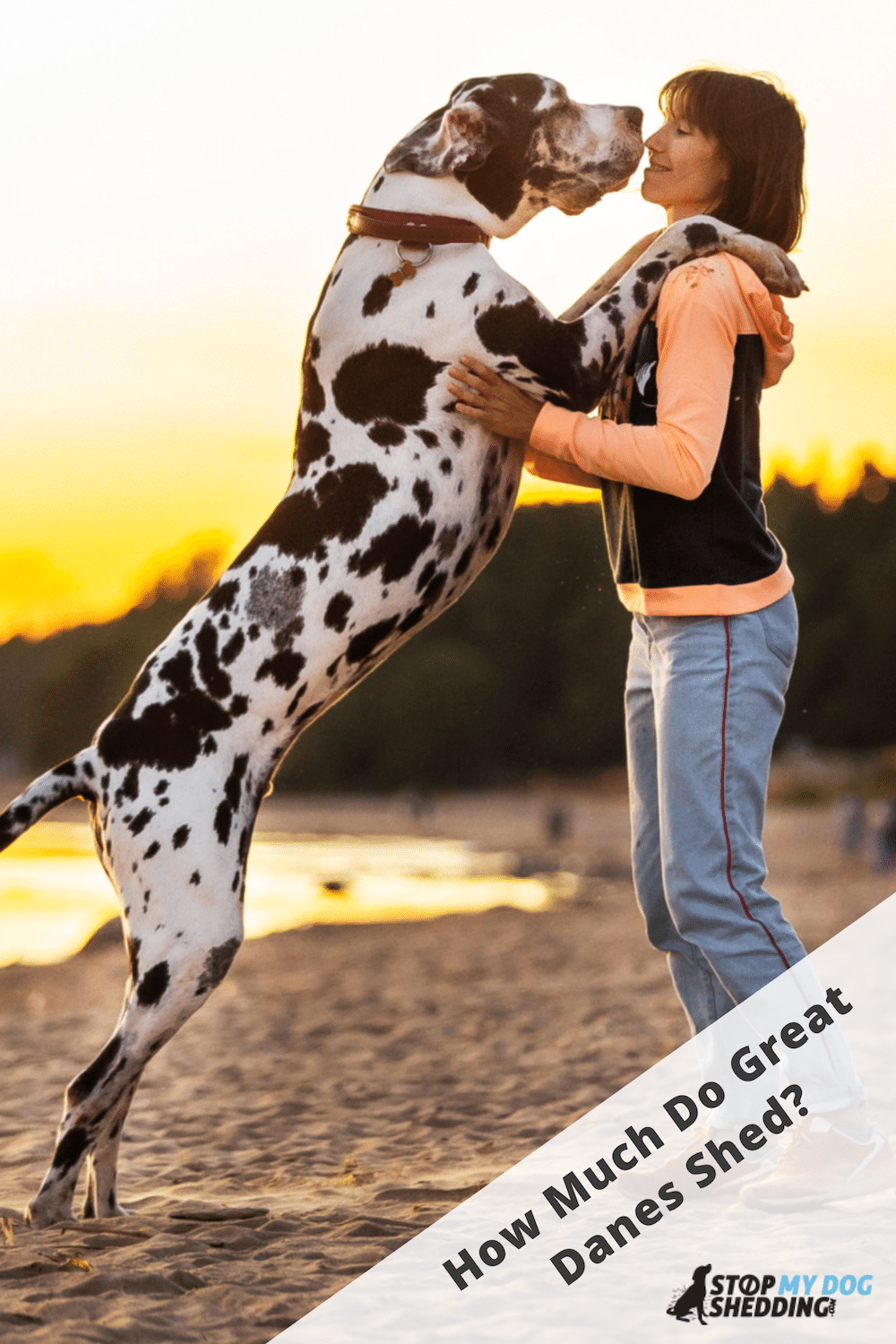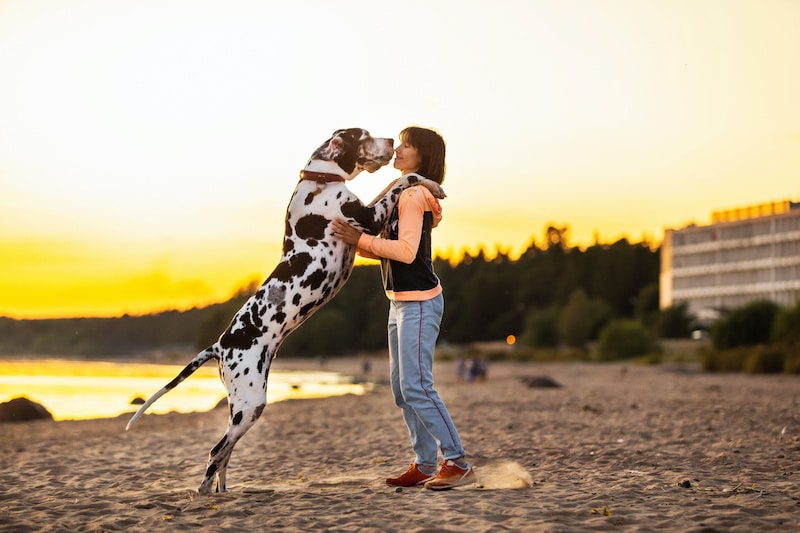Great Danes are gentle giants that originate from Germany. They can be quite intimidating, and do make excellent guardians, but they also love people and are generally very easy going.
Do they shed much? Great Danes are a moderate to high shedding breed. The reason they shed so much has a lot to do with the sheer size of their body, there’s just so much hair that can fall out. They tend to shed about the same amount year round, except during spring and fall when this can intensify.
In this article, we’ll take a closer look at how and why these beautiful beasts shed, what they’re like to groom, and what makes them so special.
Recommended: Go here to see our top-rated dog hair blow dryers
Great Dane Shedding
Great Danes shed a moderate to high amount of hair.
The amount they shed isn’t as bad as a high shedding breed like the German Shepherd for example, but typically more than a low shedding breed like the Rhodesian Ridgeback.
A lot of people assume that because they have short hair, they won’t shed much, but this simply isn’t the case. How much a breed sheds is ultimately not dependent on the length of their coat alone.
What it has more to do with, at least in the case of a Great Dane, is the sheer size of their body. These guys can stand up to a whopping 32 inches (81 cm) tall and weigh up to 175 pounds (79 kg). That’s one big dog! And because of this, there’s just so much hair they can lose in comparison to a smaller breed.
So in other words, the “rate of shedding” in a Great Dane isn’t particularly high, but because they’re such a large breed, even a low rate of shedding is going to result in a fair amount of hair falling out overall.
It’s also worth mentioning that they tend to shed more during spring and fall as their coat prepares for the upcoming change in weather. This is normal and thankfully not as bad as a breed with a double coat with longer hair, like a Bernese Mountain Dog, but you will typically notice more shedding during these times.
What Are They Like to Groom?
Great Danes are very easy to maintain, a simple brush once or twice per week is all you really need to do to keep the shedding under control and their coat in good shape.
With respect to shedding, brushing helps in a couple of ways.
First, brushing removes the dead hairs from the source. The more you brush, without going overboard, the less hairs that will end up throughout your home. Makes sense.
The second reason is because brushing actually helps to spread the oils of the Great Danes coat evenly over his skin, which helps prevent dry skin and leads to a naturally healthier coat.
What sort of brush should you use?
The best type of brush to use is a bristle brush or rubber hand mitt. They don’t have an undercoat, and their coat is short and smooth, so this is all you really need to get the job done.
A de-shedding tool is probably going to remove more hairs in less time, so could be worthwhile if you want to bring out the big guns. But these do cost a bit more than a bristle brush depending on which brand you end up buying. Check out our shedding brush comparison article to learn more.
How often should you brush?
Once per week is enough to keep their coat healthy, but if you’re noticing a lot of loose hairs falling out, you can safely step this up to every day or every other day if you’re using a bristle brush, since these typically won’t irritate their skin if used regularly.
Are Great Danes Hypoallergenic?
No, Great Danes are definitely not hypoallergenic.
But the truth is, every dog on the planet, including hairless breeds, can cause allergies if the person is sensitive enough to the allergens dogs produce.
And the reason is because these allergens don’t come from the hair itself, they come from the dogs dander (dead flaking skin) and dried saliva. And these allergens attach themselves to the dogs coat. So, when they shed, the stuff that makes you sneeze finds its way into more areas of your home.
In other words, no dog is 100% hypoallergenic, but dogs that shed less hair are generally considered more hypoallergenic than high shedders. And since Great Danes do shed a fair bit, they are not considered hypoallergenic.
Reducing Excessive Shedding
The easiest way to reduce shedding in your Great Dane is to brush regularly. There is no magic cure because all dogs shed, it’s a natural occurrence that is actually healthy for the dog.
When they shed, it just means old hairs are falling out, and new ones are taking their place. So you definitely don’t want to try to stop this, nor could you anyway.
With that being said, brushing is a very simple, and effective, method of reducing the amount of fur that falls onto the floor. And it’s not difficult to do because their coat is short and smooth, and they don’t have a double coat, which makes them one of the easiest dogs to groom out there.

There are some other things you can do besides brushing, to make life easier and reduce how much time you spend cleaning up dead hairs.
The first is not so much what to do, but what not to do. If you bath your Great Dane, which many people do, avoid using human shampoo. Replace it with a high quality dog shampoo, with as few chemicals as possible, that promotes a moisture rich coat.
The other thing you can look at is his diet. The better your dog’s diet, the healthier his coat is going to be, and the less hair he will shed. It’s up to you exactly what you buy, but generally speaking, dog food that is rich in nutrients, vitamins and minerals, as well as Omega 3s like salmon, tuna and flaxseed, is ideal.
You can also consider using a natural home shedding remedy like coconut oil for example, which you can add to his food (in moderation) to further promote moisture in the skin and coat.
You may not be able to stop shedding completely, but a regular brushing routine, healthy diet and avoiding things that dry out his skin, will go a long way to significantly minimize it.
You can learn more about reducing shedding here.
Recommended: Go here to see our top-rated dog hair blow dryers
Should You Adopt a Great Dane?
Great Danes are very large dogs. In fact, they’re the tallest breed of dog in the world. But they’re just as gentle and have a relaxed, easy going nature.
They really do love people and make great family companions. Even though they’re huge and somewhat intimidating, they’re typically great around kids and play well with other dogs too.
What’s their story? Great Danes originated in Germany in the 1800’s, where they were bred to hunt wild boars. They were often referred to as the “Apollo of Dogs”, the Greek god of sun and light, probably because of how tall and powerful they are.
Who are they best suited to? Great Danes make excellent companions for the whole family. They don’t bark much either, so won’t annoy the neighbors. But they’re probably best suited to someone with a yard given their sheer size and the fact that they need regular exercise, despite being happy to lounge around the home with the family.
Just be prepared to spend quite a bit on food, since they eat more than most people, and go back for seconds.
Either way, if you’re not concerned about the shedding side of things and want a low maintenance family companion, as well as a diligent guardian, then the Great Dane is for you.
FAQ
How Bad Do Great Danes Shed?
Great Danes shed a moderate to high amount of hair year round, but this is easy to get under control through regular brushing with a bristle brush or rubber hand mitt.
Why Do They Shed So Much?
The reason they shed so much is mostly because of their size, there’s just a lot more surface area of hair that can fall out in comparison to smaller breeds.
Do They Bark Much?
Great Danes don’t bark much, and are basically the opposite of breeds like the Beagle for example. They’re cool, calm and collected and generally only bark when there’s a genuine need to do so.
Are Great Danes Good With Kids?
Despite their enormous size and somewhat intimidating appearance, Great Danes make excellent family companions and, as a breed, are generally very good with kids.
Similar Breeds That Shed Less?
Other large breeds of dog that shed less hair include the Airedale, Scottish Deerhound, Saluki and Black Russian Terrier. But some of these will require more grooming effort and have different temperaments, so it ultimately comes down to your personal preference.













Please note: By submitting a comment using the above comment form, you confirm that you agree with the storage and handling of your data by this site as detailed in our Privacy Policy.